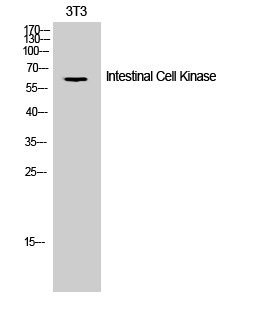Intestinal Cell Kinase Polyclonal Antibody
- SPECIFICATION
- CITATIONS
- PROTOCOLS
- BACKGROUND

Application
| WB, IHC-P |
|---|---|
| Primary Accession | Q9UPZ9 |
| Reactivity | Human, Mouse, Rat |
| Host | Rabbit |
| Clonality | Polyclonal |
| Calculated MW | 71427 Da |
| Gene ID | 22858 |
|---|---|
| Other Names | ICK; KIAA0936; Serine/threonine-protein kinase ICK; Intestinal cell kinase; hICK; Laryngeal cancer kinase 2; LCK2; MAK-related kinase; MRK |
| Dilution | WB~~Western Blot: 1/500 - 1/2000. Immunohistochemistry: 1/100 - 1/300. ELISA: 1/20000. Not yet tested in other applications. |
| Format | Liquid in PBS containing 50% glycerol, 0.5% BSA and 0.09% (W/V) sodium azide. |
| Storage Conditions | -20℃ |
| Name | CILK1 |
|---|---|
| Synonyms | ICK, KIAA0936 |
| Function | Required for ciliogenesis (PubMed:24797473). Phosphorylates KIF3A (By similarity). Involved in the control of ciliary length (PubMed:24853502). Regulates the ciliary localization of SHH pathway components as well as the localization of IFT components at ciliary tips (By similarity). May play a key role in the development of multiple organ systems and particularly in cardiac development (By similarity). Regulates intraflagellar transport (IFT) speed and negatively regulates cilium length in a cAMP and mTORC1 signaling- dependent manner and this regulation requires its kinase activity (By similarity). |
| Cellular Location | Nucleus. Cytoplasm, cytosol {ECO:0000250|UniProtKB:Q62726}. Cell projection, cilium. Cytoplasm, cytoskeleton, cilium basal body {ECO:0000250|UniProtKB:Q9JKV2}. Note=Also found at the ciliary tip (PubMed:24797473). Nuclear localization has been observed with a GFP- tagged construct in transfected HeLa cells (PubMed:12103360, PubMed:19185282). |
| Tissue Location | Expressed in heart, brain, placenta, pancreas, thymus, prostate, testis, ovary, small intestine and colon, with highest levels in placenta and testis. Not detected in spleen. Also expressed in many cancer cell lines. |

Thousands of laboratories across the world have published research that depended on the performance of antibodies from Abcepta to advance their research. Check out links to articles that cite our products in major peer-reviewed journals, organized by research category.
info@abcepta.com, and receive a free "I Love Antibodies" mug.
Provided below are standard protocols that you may find useful for product applications.
Background
Required for ciliogenesis (PubMed:24797473). Phosphorylates KIF3A (By similarity). Involved in the control of ciliary length (PubMed:24853502). Regulates the ciliary localization of SHH pathway components as well as the localization of IFT components at ciliary tips (By similarity). May play a key role in the development of multiple organ systems and particularly in cardiac development (By similarity). Regulates intraflagellar transport (IFT) speed and negatively regulates cilium length in a cAMP and mTORC1 signaling-dependent manner and this regulation requires its kinase activity (By similarity).
If you have used an Abcepta product and would like to share how it has performed, please click on the "Submit Review" button and provide the requested information. Our staff will examine and post your review and contact you if needed.
If you have any additional inquiries please email technical services at tech@abcepta.com.













 Foundational characteristics of cancer include proliferation, angiogenesis, migration, evasion of apoptosis, and cellular immortality. Find key markers for these cellular processes and antibodies to detect them.
Foundational characteristics of cancer include proliferation, angiogenesis, migration, evasion of apoptosis, and cellular immortality. Find key markers for these cellular processes and antibodies to detect them. The SUMOplot™ Analysis Program predicts and scores sumoylation sites in your protein. SUMOylation is a post-translational modification involved in various cellular processes, such as nuclear-cytosolic transport, transcriptional regulation, apoptosis, protein stability, response to stress, and progression through the cell cycle.
The SUMOplot™ Analysis Program predicts and scores sumoylation sites in your protein. SUMOylation is a post-translational modification involved in various cellular processes, such as nuclear-cytosolic transport, transcriptional regulation, apoptosis, protein stability, response to stress, and progression through the cell cycle. The Autophagy Receptor Motif Plotter predicts and scores autophagy receptor binding sites in your protein. Identifying proteins connected to this pathway is critical to understanding the role of autophagy in physiological as well as pathological processes such as development, differentiation, neurodegenerative diseases, stress, infection, and cancer.
The Autophagy Receptor Motif Plotter predicts and scores autophagy receptor binding sites in your protein. Identifying proteins connected to this pathway is critical to understanding the role of autophagy in physiological as well as pathological processes such as development, differentiation, neurodegenerative diseases, stress, infection, and cancer.


